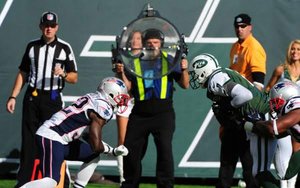
A number of
commentators have weighed in over the last few weeks with their opinions on why ratings for the NFL on TV have fallen by double-digit percentages this season.
A few
weeks ago, a 15% dropoff was reported. More recently, the decline was reported as 11% so far this fall. Whatever it is, or whatever it turns out to be by the time the season ends, the National
Football League and its TV partners are not accustomed to double-digit audience declines.
Football was supposed to be the great constant of TV. Viewers of
scripted prime-time shows going elsewhere lately? Don’t worry, they’ll come back for football. They always do. Or maybe not.
So what’s the
problem? The commentators have pointed to a variety of factors – all of them valid and likely contributing, by degrees, to this viewership shortfall.
advertisement
advertisement
In no particular order, they include the generalization that the games haven’t been that great this season, or the match-ups that attractive (particularly in the prime-time games
where the ratings are most valuable).
Others say there are no real superstars in the league these days who are (a) likable (i.e., charismatic) and/or (b) so
electrifying in their on-field performances that you feel you just have to watch them. Speaking of superstars, others point to the Tom Brady “deflate-gate” cheating scandal as the kind of
thing that breeds cynicism (if not contempt) among football fans.
The rise of fantasy football gets mentioned too. According to multiple commentators,
fantasy football is overtaking the real thing in popularity. Who needs actual football when you can call the shots in your own football fantasy world?
Still
others say the advent of prime-time games on Thursday nights is having an over-saturation effect. What’s next? Pro football on Wednesday nights? How about Tuesday?
These commentators note that football seems to be at its strongest when it is confined mostly to weekends, particularly on Sunday. And it’s true: Watching football on
Sunday afternoons is an American tradition. Why dilute it with games on other days?
I have at least two pet peeves of my own about the NFL. One has to
do with uniforms. While this might seem petty at first glance, the uniforms that football teams wear are a major element in the overall visual package that the league and the TV networks build for
their game telecasts.
This season, I have seen various teams decked out in monochromatic uniforms that have their players wearing bright Day-Glo colors from
head to toe. These uniforms make these macho football players look as if they’re wearing leotards. They look ridiculous.
Speaking of ridiculous,
the NFL has gone loopy in its insistence that its teams don “throwback” uniforms for a game or two every season. This is meant to drive sales at the NFL store. Earlier this season, I saw a
Pittsburgh Steelers game where the team wore uniforms of black and yellow stripes that had them looking like bumblebees. It was an embarrassment.
Another beef I have
are the games the NFL insists on playing in London. These games serve no one -- not the NFL fans, not the TV audiences, not the teams and players. Last month, a New York Giants game in London was seen
at 9:30 a.m. on a Sunday morning. What is this? Tennis?
NFL games do not belong on TV on Sunday morning. Moreover, this scheme does not appear to be growing the
popularity of American football in the U.K. I hear the papers and other sports media there don’t even report on these games. Why? Because they’re not soccer. Duh.
And then there is the tarnished image of the NFL players. The assaults on wives and girlfriends are a concern, of course, but at least you can say reliably that this group
does not comprise the majority of NFL players.
But if there is a visual on TV that will turn off American football fans in droves, it’s the sight of
wealthy, spoiled athletes such as Colin Kaepernick and other players disrespecting the national anthem. What makes this situation worse is the NFL’s seeming refusal to correct this behavior, as
if the league is afraid it will be pilloried in social media if it moves to prohibit such sideline protests.
From Day-Glo uniforms to millionaire athletes
acting as if they are victims of persecution, the NFL today is a morass of poor judgments and lax discipline. And it’s driving viewers away from the only kind of programming the networks thought
they could still count on.